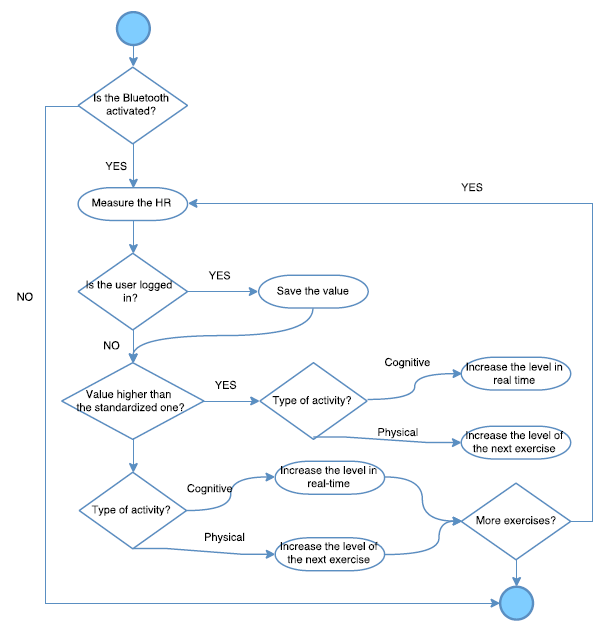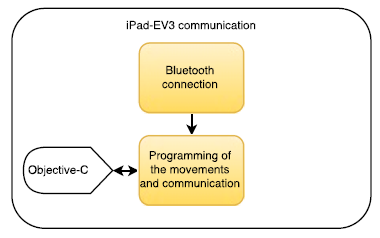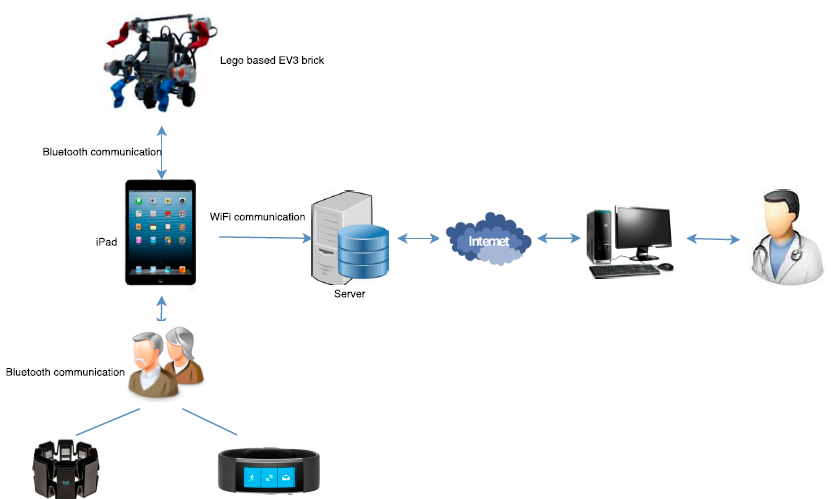ABSTRACT
This publication presents a complete description of a technological solution system for the physical and cognitive rehabilitation of elderly people through a biofeedback system, which is combined with a Lego robot. The technology used was the iOS’s (iPhone Operating System) Objective-C programming language and its XCode programming environment; and SQLite in order to create the database.
The biofeedback system is implemented by the use of two biosensors which are, in fact, a Microsoft band 2 in order to register the user’s heart rate and a MYO sensor to detect the user’s arm movement. Finally, the system was tested with seven elderly people from La Santa y Real Casa de la Misericordia nursing home in Bilbao. The statistical assessment has shown that the users are satisfied with the usability of the system, with a mean score of 79.29 on the System Usability Scale (SUS) questionnaire.
METHODS
Section 2.1 provides a complete description of the system design, whose general architecture is summarized in Figure 1. As shown, the iPad features an iOS (iPhone Operating System) application containing the serious games which the user will interact with. Furthermore, performance of the serious game will be conditioned by the data received from two sensors: the MYO (Thalmic Labs, Canada) and the Microsoft band (Microsoft Corp., Redmon, WA, USA). It must be noted that both sensors are connected to the iPad through a Bluetooth Low Energy (Bluetooth LE) connection.

Figure 4. Flowchart diagram of the heart rate (HR)
On the other hand, as shown in Figure 4, if the Bluetooth LE is activated, the system will begin to measure the data every second. In the case that the user is logged in, the system will save the results to the local database. If the value is higher than the standardized ones, the activity will immediately decrease its difficulty or, in contrast, if the value is lower than expected, the system will increase the difficulty of the activity.

Figure 5. Communication protocol between the iPad and the EV3 brick
The main purpose of this third stage is to design the communication between the iPad mini and the Lego EV3 brick. As shown in Figure 5, both devices are connected though a Bluetooth connection whose protocol is implemented in the iOS device through the XCode programming environment.
RESULTS AND DISCUSSION

This section will analyze and present the feedback gathered from the trials and questionnaires that were conducted at the Santa y Real Casa de la Misericordia nursing home in Bilbao. Table 1 shows the results obtained from the SUS questionnaire. According to this questionnaire, the system is thought to be well-designed if the mean obtained is above 68. Hence, as shown in the Table 1, with a mean score of 79.29 points, the system is considered to be well-designed in terms of usability.

The correlations between the total score obtained in the SUS questionnaire and the different major variables are shown in Table 4. From the table it can be seen that the scores obtained in the SUS questionnaire did not depend on how well the user performed the activity, both in the case of the MYO sensor and when not using the mentioned electromyography sensor. However, between the SUS and QUIS questionnaires, a strong correlation was detected in the information section (R = 0.683, p = 0.033).
CONCLUSIONS
This section, will discuss the strengths and limitations that have been concluded from the results during the testing phase of the described system.
Strengths
On the one hand, the main strength of this project is the combination of biofeedback techniques with Lego robots and serious gaming with the aim of providing both cognitive and motor rehabilitation for elderly people. On the other hand, this project provides elderly people with not only a cognitive and motor rehabilitation tool, but with a personalized tool for rehabilitation and monitoring. It is thus adapted to each user’s needs and cognitive and physical level.
Limitations and Perspectives
In order to improve to improve the implementation of the biofeedback system in terms of the heart rate parameters, an Electrocardiography (ECG) sensor could be included instead of the Microsoft band that is now being used. With the ECG sensor, the system could obtain the heart rate variability which, in fact, provides more accurate information than the heart rate value.
One of the main improvements that could be included in this system is automated data analysis through cloud computing techniques. Furthermore, the inclusion of more biomedical sensors would be an excellent possibility for this project as the addition of sensors such as Galvanic Skin Response (GSR) sensors and stress sensors could improve the biofeedback module of the system.
Source: University of Deusto
Authors: Leire Lopez-Samaniego | Begonya Garcia-Zapirain
>> Best Computer Science Student DBMS Projects using MS Access
